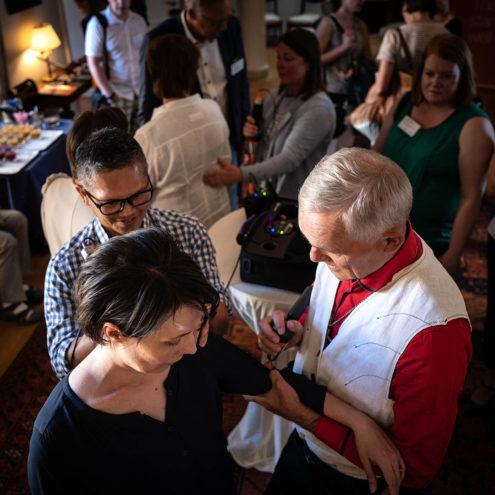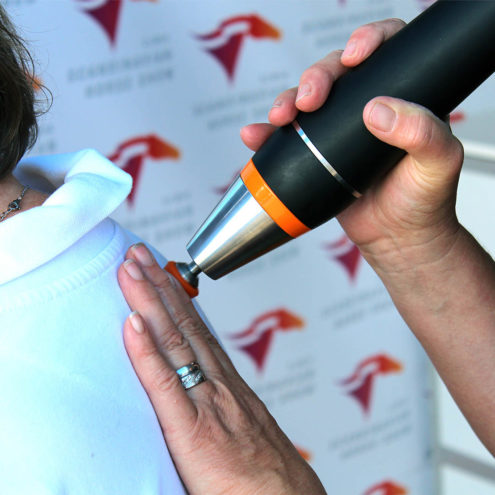Restless Legs Syndrome – Advice and Treatment

Restless Legs Syndrome (RLS), also known as Willis-Ekbom’s disease, is a neurological condition characterized by an irresistible urge to move the legs, usually due to unpleasant sensations. Most often, RLS affects women and the elderly.
What are tingles in the legs?
Symptoms and how they affect everyday life
People with RLS often experience unpleasant sensations in their legs, which can be described as crawling, tingling, burning, twitching or trembling. Many also experience a deep seated ache in their legs. These sensations lead to an overwhelming desire to move the legs, which is often exacerbated when sitting or lying down, especially in the evenings and at night. This can have a major impact on a person’s quality of sleep and can lead to fatigue and reduced quality of life.
Common causes and risk factors
The causes of RLS are not fully understood, but the condition has been linked to:
Genetic factors: A family history of RLS increases the risk of developing the disease.
Pregnancy: Hormonal changes during pregnancy can trigger or worsen RLS.
Age: The risk of developing RLS increases with age.
Iron deficiency and other nutrient deficiencies can also contribute to the symptoms of RLS.
Association with other medical conditions
RLS can also be associated with other medical conditions such as:
Chronic kidney failure and dialysis
Diabetes
Neuropathy
Iron deficiency and anemia
Parkinson’s disease
Why do you get tingles in your legs?
Dopamine imbalance and the role of the brain
An imbalance in the neurotransmitter dopamine, which is important for regulating movement, is thought to play a central role in RLS. Disruptions in the dopamine system can lead to irregular nerve signals that cause RLS symptoms.
Genetic factors
Research shows that RLS can be hereditary. Several gene variants have been linked to an increased risk of developing the condition.
Iron deficiency and other nutritional conditions
Iron deficiency, even without anaemia, can affect dopamine levels in the brain and thus contribute to RLS. Other nutritional deficiencies, such as magnesium or folate, may also play a role.
Influence of pregnancy
Pregnancy, especially in the third trimester, can increase the risk of RLS. Symptoms usually subside after childbirth, but women who develop RLS during pregnancy are often at greater risk of developing it later in life.
What symptoms cause or are signs of tingling in the legs?
Unpleasant sensations in the legs and the need to move them
One of the most prominent symptoms of leg tingling is a strong urge to move the legs, which is often experienced as being caused by unpleasant sensations in the limbs. These can include crawling, tingling, itching, burning, or like something is crawling under the skin. Symptoms can range from mild to very unpleasant. Symptoms usually occur when the individual is inactive or at rest, especially in the evenings and nights.
Sleep disorders and its effects on daytime
The constant need to move their legs can lead to waking from sleep. This makes it difficult for individuals with RLS to fall asleep or sleep through the night. Sleep deprivation, in turn, can lead to daytime fatigue with reduced concentration and mood swings. Sleep disturbances can also increase the risk of other health problems, such as depression and cardiovascular disease.
The link to periodic movements of limbs during sleep
Many people with RLS also experience periodic limb movements in sleep (PLM). This is caused by muscle contractions during sleep that cause the limbs to move. Although the individual may not be aware of these movements, they can interrupt the sleep cycle and further impair sleep quality, leading to tiredness and fatigue during the day.
Treatment of Restless legs
If you suffer from restless legs, there are various methods that can reduce your symptoms.
Physiotherapy and exercise: Specific exercises or physiotherapy treatments can increase circulation and reduce the symptoms of RLS. Stretching is also said to improve the condition.
Drugs: For some people, drugs that increase dopamine levels in the brain can reduce the symptoms of RLS. In some cases, opioids can be used when previous drugs have not been effective. Drugs for iron deficiency may also be used.
Reduce factors that can worsen symptoms. Some medicines such as antidepressants and antihistamines can worsen the symptoms of RLS. Caffeine can also have an effect.
Regular follow-up is important for long-term treatment with medicines. The effect, possible side effects and possible dose adjustments should be monitored. At high doses, some medicines can worsen the symptoms of RLS.
By understanding the underlying causes and risk factors for RLS, individuals and healthcare providers can work together to develop effective treatment strategies. These may include lifestyle changes, medication, and management of any underlying medical conditions that may contribute to symptoms. If you suspect you have RLS, it is important to seek medical advice to get an accurate diagnosis and appropriate treatment.
 Search
Search


































